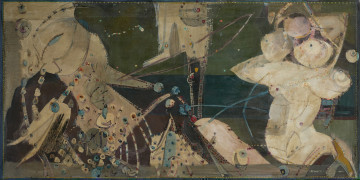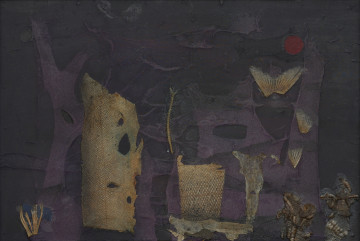
Cannibal Ship
1972
National Museum in Szczecin
Part of the collection: European classics of modernity
Jonasz Stern began his artistic education with private painting lessons given by Paweł Gajewski, a former pupil of Wojciech Weiss and lecturer at the School of Decorative Arts and Industry in Lviv. In 1928, he enrolled at Ludwika Mehoffer's Free School of Painting and Drawing in Kraków. From 1929 to 1935, he studied at the Academy of Fine Arts there, where he attended the studios of Teodor Axentowicz, Władysław Jarocki, Stanisław Kamocki and Fryderyk Pautsch. However, it was not so much the artists of the Young Poland movement who influenced the young Stern's creative path as the milieu of his peers with its radical leftist views (Sasha Blonder, Maria Jarema, Leopold Lewicki, Adam Marczyński, Stanisław Osostowicz, Henryk Wiciński), which founded the Kraków Group in 1931. Their inclination towards an avant-garde formal language, drawing on the achievements of cubism, abstraction and surrealism, was supported by inter-community exchanges with the Artes group from Lviv and the a.r. group from Łódź. Stern recalled: We represented the province - uncouth, hungry, ardent, not blasé with bourgeois manners, not bound by connections to the Olympus of Krakow. We were wild strangers who came to the Polish Athens to become somebody (Grupa Krakowska, in: Cyganeria i polityka. Wspomnienia krakowskie 1919-1939 [[Bohemia and politics. Kraków memories 1919–1939], ed. by Janina Bogucka-Ordyńcowa, Warsaw 1964, p. 227). Frequent arrests as a member of the Polish Communist Party, a stay in Bereza Kartuska, later in the Lviv ghetto and the local Janów Camp, an escape from a place of execution and wandering through Hungary to Kraków had a significant influence on the painter's mature artistic output. However, he contacted the circle of Modernists centred around Tadeusz Kantor (Grupa Młodych Plastyków, Klub Artystów) and, apart from works related to his war experiences, he returned to formal experiments. During the Modern Art Exhibition (1948/1949), he presented four abstract compositions numbered with Roman numerals, the painting of which he continued despite the announcement of socialist realism as the only binding creative method. The Szczecin painting belongs to this series.
Szymon Piotr Kubiak
Author / creator
Dimensions
cały obiekt: height: 80 cm, width: 60 cm
Object type
painting
Creation time / dating
Creation / finding place
Identification number
Location / status

1972
National Museum in Szczecin

1969
National Museum in Szczecin

1966
National Museum in Szczecin
DISCOVER this TOPIC
Castle Museum in Łańcut
DISCOVER this PATH
Educational path